
Senior Capstone Projects (2012-2013)
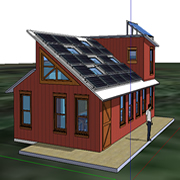 Designing a Sustainable Field Research Station for Skidmore College’s Off Campus Properties
Designing a Sustainable Field Research Station for Skidmore College’s Off Campus Properties
Marcus Goldbas, Gwyn Harris, and Lily Alverson (2013)
We developed an architectural design for a field station that will increase the use of Skidmore’s forested properties for teaching, learning, and outdoor activities, while implementing sustainable design strategies to limit the environmental impacts on the surrounding landscape. We combined stakeholder analyses with evaluations of siting, orientation, climate, access/transportation, solar energy, passive solar heating, storm water management, rainwater catchment, day lighting, and materials, and offer a proposal to the Skidmore Community.
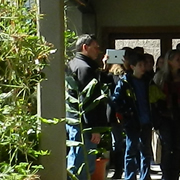 Saratoga’s First Green Home Tour: A Social Experiment
Saratoga’s First Green Home Tour: A Social Experiment
Rene deJongh, Melissa Green, and Stephanie Seidmon (2013)
As an individual, your single most significant impact on the natural environment is your choice of home and behaviors within the home. As a result, the residential sector in the United States accounts for 40% of our carbon emissions. If energy efficient homes have a smaller environmental impact and save the consumer money, why don’t more people build green homes? In this study we explored the perceptions and behaviors of Saratoga County residents about building green and retrofitting homes through interviews and surveys and how a Green Home Tour could serve as a method of education to spread awareness of green building.
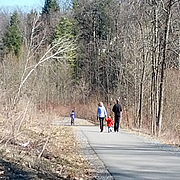 Grand Plans, Trails to Nowhere: An Analysis of Multi-Use Trails in Saratoga Springs
Grand Plans, Trails to Nowhere: An Analysis of Multi-Use Trails in Saratoga Springs
Nate Blanks, Sarah Marks, and Dan Raudonis (2013)
The trail network in Saratoga Springs is underdeveloped and despite numerous plans
a cohesive trail network is still far from being a reality. We assess the factors
that affect trail creation through historical and first-hand research. Key barriers
to trail implementation include funding, government will and communication. Ultimately,
we make recommendations for how to improve future trail efforts in the area, including
a current plan to create a 10-mile network of trails.
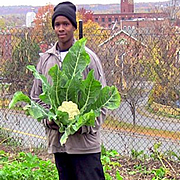 Social Capital and Soils in the Community Gardens of the Capital District: What they
put in and what they take out
Social Capital and Soils in the Community Gardens of the Capital District: What they
put in and what they take out
Olivia Miller, Abby Smith, and Emily Hudspeth (2013)
What are the social and physical characteristics of community gardens in the Capital District? How does location (urban, suburban, rural?) influence the functionality of gardens? Using a survey, we examined gardener perceptions of and contributions to community, both inside and outside garden walls. We analyzed soil type and impervious surface cover data as well. We created a ranking system to determine those gardens that exhibit the “best” and “worst” characteristics. These results were mapped using GIS which allowed us to find correlations between location and garden success. We found that location has the most impact on impervious surface and community within the garden whereas soil type and engagement with the surrounding community are more variable and depend on other factors besides location.
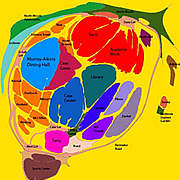 Conceptual Landscapes on Skidmore Campus: Reconciling Perception and Reality
Conceptual Landscapes on Skidmore Campus: Reconciling Perception and Reality
Hannah Greendorfer, Meghan Burke, and Abby Wyant (2013)
Colleges are constantly adapting to internal and external pressures. In the past ten years Skidmore College has increased in size and scope. Our project aims to illustrate how the Skidmore population views and interacts with the college campus. We investigate the conceptualizations of space using cognitive maps drawn by members of the Skidmore community. The assessment of space can then influence future developments and supports sustainable design and a strong Skidmore community.
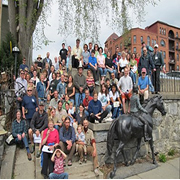 The Times They Are A-Changin': Shifting Environmentalism in Saratoga Springs
The Times They Are A-Changin': Shifting Environmentalism in Saratoga Springs
Riley Johnson, Gabby Stern, and Sarah Risley (2013)
Is the environmental movement really dead? We applied this question to Saratoga Springs
and came to our own conclusion: It certainly is not! Saratoga Springs has a vibrant
movement that thrives at the local level and addresses an array of environmental issues.
Although environmentalism is not dead in Saratoga, the grassroots are transforming.
We analyze the state of the movement and how it is continuing to flourish in a new
way.
 Videos Unplugged: Combining Comedy with Consequence
Videos Unplugged: Combining Comedy with Consequence
Racquel Figueroa, Eric Stumpf, and Anthony DiLisio (2013)
What does it take to make an effective video PSA for the Skidmore Unplugged energy saving campaign? We surveyed students about their usage of electrical devices to identify the sources of energy consumption and key behaviors to target. We made ten videos exploring the themes of humor, social influence and environmental concern. Focus group discussions showed that a combination of these themes would be most effective for the college audience. Other key aspects were brevity, shock value, personal relevancy and specificity of both target behavior and audience.
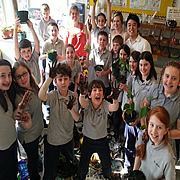 Growing Good Habits: A Garden-Based Approach to Fourth & Fifth Grade Learning
Growing Good Habits: A Garden-Based Approach to Fourth & Fifth Grade Learning
Haley Duncan, Anna-Beth Lawler, and Duke Yun (2013)
Today, children face depravation from nature, unhealthy eating habits, and limited physical activity. Garden-based learning can address all of these issues, while also enhancing science classes. We developed a 5-week indoor, garden-based, after-school program with fourth and fifth graders from St. Mary's elementary school in Ballston Spa to measure their effectiveness. Successful gardening programs must create allies within the school and ultimately influence in-classroom curriculums.
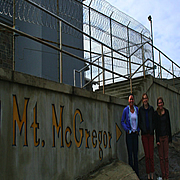 Breaking In: Educating Prisoners Through Environmental Literacy
Breaking In: Educating Prisoners Through Environmental Literacy
Sondra Lipshutz, Kristen Stearns, and Sarah LaBella (2013)
How can the impact of the environmental movement reach underserved communities? Our
project involved seeking nontraditional allies in prisoners, working with Mt. McGregor
Correctional Facility in Wilton, NY to implement an environmental literacy program
for inmates. Literature, film, and interactive activities introduced inmates to topics
from climate change to green jobs. We used pre- and post-surveys to evaluate the program
and made suggestions for future Skidmore/prison collaboration in the field of environmental
studies.
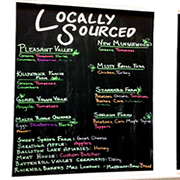 Why Local: An Examination of Motivations and Barriers to Integrating Local Food in
Saratoga Restaurants
Why Local: An Examination of Motivations and Barriers to Integrating Local Food in
Saratoga Restaurants
Lauren Markram, Julia Paino, and Holden Greene (2013)
Which restaurants in Saratoga County use local foods, what are their motivations,
and what are the barriers that prevent expansion of this market? To answer these
questions, we conducted a multi-method study combining food systems theory with market
theory. Our findings suggest that Saratoga residents are interested and willing to
pay more for local food, but that lack of communication between stakeholders has created
market inefficiencies that must be addressed in order to facilitate greater integration
of local food in Saratoga restaurants.